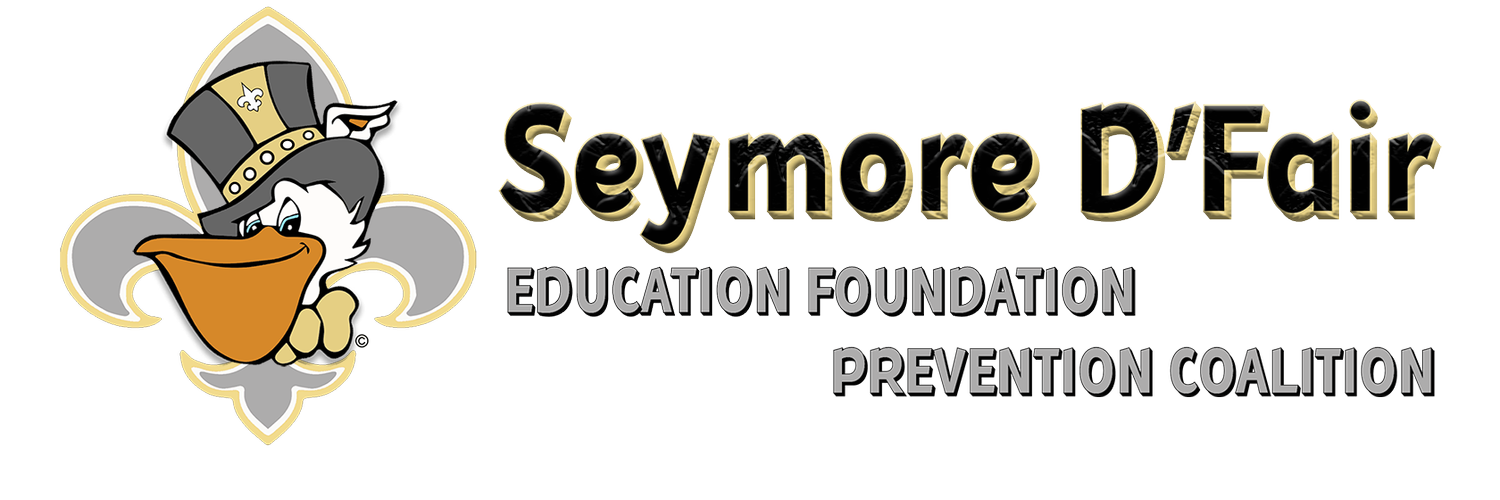SUPPORT COMPREHENSIVE SUBSTANCE PREVENTION STRATEGIES FOR ALL COMMUNITIES!
The Seymore D’ Fair Foundation and the Children & Youth Prevention Coalition of St. Tammany Parish support a comprehensive prevention strategy for Louisiana, and America. We believe that prevention networks, strong community leaders, coalitions, diligent law enforcement, and education are the keys to changing public attitudes toward drug, alcohol, and tobacco use. Proven and effective prevention tactics include promoting demand reduction principles[1] and raising awareness of the consequences of alcohol, tobacco, and drug abuse and addiction on an individual, community, state, and national level.
Preventing Drug, Alcohol, and Tobacco Use in Louisiana and America
Drug, Alcohol, and Tobacco use should be targeted through educational efforts to deliver a clear and concise message of avoidance and abstinence.
Businesses, philanthropic organizations, and government all bear the costs of alcohol, tobacco, and drug use/abuse and, therefore, should commit to funding prevention efforts at every level for the short and long term.
Systematic research should be funded via private and public efforts to identify the best methods of communicating a “drug-free” message and a positive attitude toward healthy lifestyle choices. Reviewing research on programs, policies, or interventions can help policymakers, program directors, educators, and others in the policy arena who have a stake in high-quality evidence determine what works.
Prevention education should be an essential and core element central to the health and well-being of every Louisiana citizen.
Our Prevention Strategies
-
The citizens of Louisiana and America need to be educated and encouraged that alcohol, tobacco, and drug use is not normal nor is it a part of any individual’s maturing process.
Provide funding for prevention efforts and education to raise awareness of the dangers of alcohol, tobacco, and drugs at every school level – from elementary to college.
Research, establish, and fund local drug courts[2] – in many instances, this is the only intervention point for some to receive the assistance they need - must be supported to help the addicted.
Research drug testing programs[3] to determine how they can aid in identifying those in need of treatment in schools and the workplace.
Enforce existing laws[4] to ensure school systems comply with legislative mandates involving mandatory drug prevention training.
-
Drug, Alcohol, and Tobacco prevention include schools, workplaces, community centers, places of worship, and families who unite to communicate an abstinence-based, healthy lifestyle.
Beginning with preadolescent youth, this should be an essential element of prevention efforts.
Communities working together to increase activities that form an alternative to alcohol, tobacco, and drug use, especially for youth.
Support and encourage traditional, complementary, and holistic treatment systems and protocols that include the family of those suffering from addiction; let that addict know that the community supports them in their efforts to achieve their goals.
-
Drug, Alcohol, and Tobacco abuse is not a rite of passage or inevitable; most students do not use drugs, alcohol, or tobacco. As such, education curricula[5] should begin in elementary and middle schools, presenting a clear, ‘avoidance and no use’ message.
School administration, parent groups, and student organizations should consistently support healthy, “drug-free” lifestyles and reject ‘safe’ or ‘responsible’ drug use messages.
The school community should encourage positive reinforcement for good choices and support consequences for inappropriate behavior.
School administrators should promote an open dialogue and listen to concerns about alcohol, tobacco, and drug use in their schools and comply with existing Legislative mandates concerning annual prevention training for K-12 grade students.
-
Parents must recognize their role, the single most influential factor in their child’s life, and rise to the challenge. Parents must educate themselves about the most commonly abused drugs and their effects.
Communicate[6] – initiate the conversation with your children about not using alcohol, tobacco, and drugs, utilize current events as examples, be honest about individual history to encourage trust, and formulate a plan about how to rescue a child from a risky situation, establish rules for expected behavior and enforce those rules consistently.
Family Engagement[7] - Children who participate in 3 meals or less weekly with family are 2 ½ times more likely to have used tobacco and marijuana.
Monitor[8] - teen activities and internet use - prescription drugs are easily obtained without a prescription via the web or your medicine cabinet and have been proven to lead to illegal drug use.
Positive Role Model[9] – children do what they see … parents teach by setting the right examples.
Faith[10] – teens involved religiously are less likely to use marijuana than a teen who isn’t.
-
[1] https://www.ibhinc.org/demand-reduction-supply-reduction/ | Demand Reduction and Supply Reduction: A Winning Policy Combination
[2] Painting the Current Picture: A National Report Card on Drug Courts and Other Problem-Solving Court Programs in the United States, Vol. I, No. 2, C. West Huddleston III; Karen Freeman-Wilson; Douglas B. Marlowe Ph.D.; Aaron Roussell
[3] Relationship Between Student Illicit Drug Use and School Drug‐Testing Policies, Ryoko Yamaguchi, Lloyd D. Johnston, Patrick M. O'Malley
[4] LA RS: 17:154 & 17:404 Requiring ALL Louisiana Schools to provide drug prevention education, per child, per grade level, per year
[5] keepin' it R.E.A.L.: A Drug Resistance Curriculum Tailored to the Strengths and Needs of Pre-Adolescents of the Southwest Monika Gosin, Flavio Francisco Marsiglia, Michael L. Hecht
[6] Persuasive Communication and Drug Abuse Prevention, Lewis Donohew, Howard E. Sypher, William J. Bukoski
[7] The National Center on Addiction and Drug Abuse Columbia University | Importance of Family Dinners
[8] Get Smart About Drugs | DEA Parent Resource | How Teens Abuse Medicine
[9] The Efficacy of Peer Leaders in Drug Abuse Prevention | Knut‐Inge Klepp, Andrew Halper. Cheryl L. Perry
[10] The National Center on Addiction and Drug Abuse Columbia University | Adolescence Substance Use – America’s #1 Health Problem
